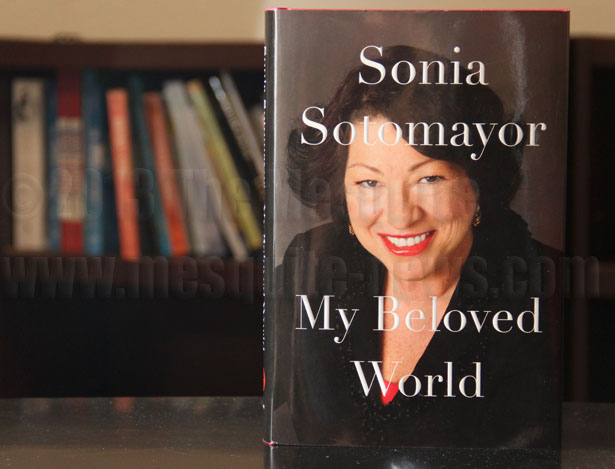
By Shawna Mount
Justice Sonia Sotomayor’s memoir, “My Beloved World,” reaches deep into her memory, recalling the events that led her to become an associate justice of the United States Supreme Court.
The justice takes a break from the bench this month to attend an 11-city book tour. Released just weeks ago by Knopf Doubleday, the memoir has risen to the number one hardcover nonfiction book on the New York Times bestseller list.
“My Beloved World” is written proof that with hard work and determination, success can be obtained. From a low income and unsupportive household in a Bronx housing project, Sotomayor rose to become the first Hispanic and third woman supreme court justice. The majority of the memoir looks back at her childhood, retracing each driven step that brought her to the present day. Written with raw honesty, Sotomayor tells her story of struggle, holding nothing back.
This captivating memoir is easily relatable for students who fall into the percentage group of minorities or first-generation students striving for a better education and future. This book will also appeal to a wide range of students, including those studying political science, women’s studies, sociology, psychology or those simply looking for an inspirational read.
Sotomayor’s road to court was not paved in gold. Instead, it was full of jagged bumps and potholes. This is what makes her memoir so uplifting and inspiring. She lived her childhood in a broken home in the middle of the Bronx, a typical background of high school dropouts. For anyone dealing with hard times, whether it be financial, a bad living situation, bad health or lack of support, this memoir is a bursting light of hope.
Sotomayor’s memoir begins at the age of seven, waking to her mother’s screaming and her father’s yelling, the two of them arguing over who would give her insulin shots. Her mother worked long hours as a nurse and her father’s alcoholism made his hands shake uncontrollably. The author recalls how his hands shook, thinking he would miss her arm entirely and jab her in the face. He ended up making a sharp puncture into her arm. It was the only way he was able to keep his aim dead on. So, to ease the fights down, she learned from her mother to sterilize the needles in boiling water and use an orange to practice giving herself insulin shots. The logic was that she would have to give herself these shots for the rest of her life so she might as well learn now.
Everyone has a safe harbor or a place of sanctuary to escape the horrors of the world. For Sotomayor, it was her grandmother’s apartment. She describes it as a place of music and wafting with the “happiest smells” of garlic and onion. The only downfall of this haven was the blame her grandmother placed on her mother for her son’s alcoholism that slowly took him further and further down. Sotomayor watched her father at parties and gatherings, waiting for the moment that she and her mother would have to drag him home once he started stumbling over himself and yelling obscenities.
“I saw my father receding from us, disappearing behind that twisted mask,” she writes. “It was like being trapped in a horror film, complete with his lumbering Frankenstein walk as he made his exit and the looming certainty that there would be screaming when we got home.”
At the age of nine, Sotomayor watched the alcoholism finally take her father. Her mother spent a long while locked up in a dark room, grieving, an unexpected reaction to the loss of her husband. To pass the time and distract her thoughts, Sotomayor began burying her head in books, but after months and months of quiet and lonely nights in front of the television with her younger brother, Sotomayor finally broke.
Maybe it was the lashing out or finally rising from the grief, but Sotomayor’s mother started in small steps to give a better future to the son and daughter she had neglected. Her mother began speaking English with them at home and bought a set of encyclopedias. Sotomayor’s response was to excel in her education. She explained in her memoir that she started by asking the smartest girl in school how to study. Then, in high school she joined the debate team, learning how to stand her ground and gain skills in public speaking. Then an older student informed her about the Ivy League and her driven attitude was one factor that gained her entrance to Princeton.
At the Ivy League she dealt with sour individuals, complaining that people like her didn’t belong. She didn’t lash out or close herself off, instead, she strove for greatness, joining a Puerto Rican student group that focused on higher enrollment of Latinos. After a C on her first mid-term paper, Sotomayor knocked out self doubt and motivated herself, resulting in the 1976 Pyne Honor Prize, the highest achievement a Princeton college senior can receive. It is awarded to seniors who have exhibited strength of character and effective leadership.
“That tide of insecurity would come in and out over the years, sometimes stranding me for a while but occasionally lifting me just beyond what I thought I could accomplish,” she writes. “Either way, it would wash over the same bedrock certainty: ultimately, I know myself.”
From the federal court of New York’s southern district, she moved on to the United States Court of Appeals for the Second Circuit and as of 2009, Sotomayor was sworn in as an associate justice of the Supreme Court.
Countless other positive reviews published in media outlets across the U.S. this month should give any reader confidence they will find value in this story.






